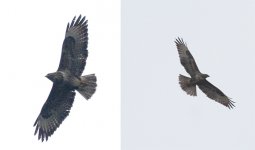Neil Grubb
Well-known member
Two buzzards were circling over my house today. I photographed both, because I noticed their shapes were different. One appears to have less broad wings, with a different wing shape, than the other, and had a broader tail. I'm fairly sure they are both common buzzards given all other ID features. Is this part of the normal variability of common buzzards, or does the right hand of the two just have more abraded plumage ? Are there subtypes of common buzzard ?
Neil
Neil








